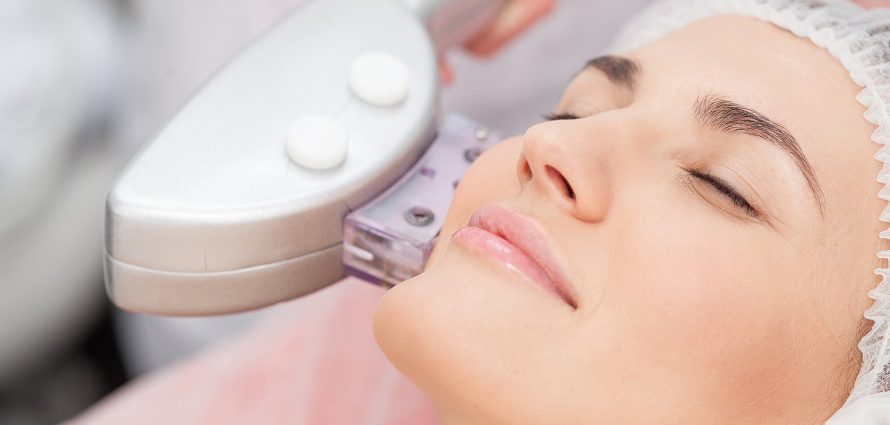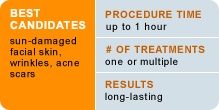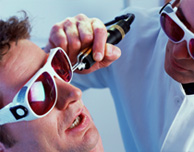Laser Skin Resurfacing for a Glowing Appearance

Reviewed by Mitchel P. Goldman, MD

One of the most popular anti-aging remedies is laser skin resurfacing, which improves the appearance of fine lines or wrinkles, scars and hyperpigmentation (discolored areas of the skin), primarily around the eyes and mouth. It can also be used to treat large areas of the face.
In 2008, there were 400,262 laser skin resurfacing procedures performed in America; up a whopping 134 percent from 2000, according to the American Society of Plastic Surgeons.
Why the dramatic uptick?
Laser skin resurfacing holds advantages over alternative approaches that may cause discomfort, bleeding and bruising, all of which equate to a longer recovery time. What’s more, today’s lasers are gentler and safer than they have been in the past.
All skin treatments work in a similar manner. They remove a layer of skin so that the new skin can flourish and fill in the wrinkles and crevices. Until recently, the only options to medically treat damaged skin were chemical peels and dermabrasion, which is more invasive and far less gentle than microdermabrasion. During dermabrasion, your surgeon uses a wire brush or a diamond wheel with rough edges to remove the upper layers of the skin. This process wounds the skin and causes it to bleed. As the wound heals, new skin grows to replace the damaged skin.
These procedures do offer the anti-aging benefits of glowing skin, reduced wrinkles, decreased areas of skin discoloration and minimal scarring, but they do not produce predictable results. By contrast, laser skin resurfacing uses laser light to target the superficial and deep layers of the skin.

There are many different types of lasers that work at various layers of the skin to treat acne scars, wrinkles and age-related skin discoloration.
For example, ablative lasers vaporize the skin away, and can result in some substantial downtime.
Examples of ablative lasers include The CO2 and Er:YAG. In 2008, 103,394 of the laser skin resurfacing techniques performed were ablative. By contrast, non-ablative lasers do not burn off the skin surface. Instead, they target the tissue under the skin and stimulate new collagen growth. There is less downtime with these lasers. In 2008, 296, 868 of the laser procedures were non-ablative or fractionated. Non-ablative lasers require multiple treatments to have an effect. Ablative lasers usually require one treatment to have a significant effect.
Fractionated lasers, such as the Fraxel, target the small areas of skin where damage has occurred, leaving the surrounding skin untouched and better able to participate in the healing process.
Intense pulsed light (IPL) is not a laser per se. It uses broad-spectrum pulses of light which are absorbed into the skin where they eliminate excessive and enlarged blood vessels and brown marks. It also will decrease pore size and minimize fine wrinkles by stimulating collagen production.
A variety of options are available for the improvement of skin through photo rejuvenation, which is the use of an energy-based device to improve the skin. Thermage, for example, uses radio-frequency energy to tighten and lift skin without any of the downtime of a surgical face lift. It is FDA-approved for the improvement of sagging skin and facial lines.
Each category of lasers may be best suited for different skin issues. During your consultation, your doctor will help you select the right laser and/or radiofrequency device for your particular skin type and problem.
For example, the Fraxel or other fractionated lasers may be best for wrinkles around the eye, while the CO2 and Er:YAG lasers may be better suited for acne scars. IPL may help treat vascular lesions and improve skin texture and color.
When Laser Skin Resurfacing May Not Be Appropriate
Not everyone is a candidate. It may take people with olive, suntanned or black skin six to nine months to regain their normal pigmentation after treatment. Others who do not make good candidates include those who are prone to scarring, are taking certain medications or have a skin disorder. Your dermatologist will evaluate your skin to determine if you are a candidate for laser skin resurfacing.
The Laser Skin Resurfacing Procedure
In the weeks before your procedure, your doctor may suggest that you apply special creams, lotions or gels to prepare your skin. You may also be given certain oral medications to take before your treatment such as antiviral, antibacterial and/or anti-yeast medication to prevent complications such as the awakening of a dormant virus.
Your doctor may perform laser skin resurfacing in the office, an outpatient surgery center or a hospital. Typically you would receive topical anesthesia, local anesthesia, and intravenous sedation so that you are awake, but not fully aware. You might even receive general anesthesia for treatment of deeper layers of the skin. The type of anesthesia is based on the laser that is used and the level of your treatment.
Treatment time ranges from a few minutes to an hour and a half, depending on the amount of resurfacing you need.
The doctor moves the laser precisely over the treatment area. Depending on the depth of the wrinkle, scar or discoloration, the laser may be moved over the area repeatedly.
The laser penetrates and removes the number of outer skin layers necessary to uncover the layer not affected by imperfections. It feels like a rubber band is being gently snapped against your skin. Once that layer is exposed, healing can begin to rebuild new skin that looks younger and does not have the imperfections.
The procedure may be performed in two or more sessions to penetrate deeper areas, but one procedure is usually enough. You may need a series of such treatments before you achieve the desired results. Multiple lasers may be used at the same time depending on your condition.
Aftercare
You may experience some temporary side effects, including swelling and mild discomfort. This can be controlled with ice packs and medications prescribed by your surgeon. There is rarely any bleeding. Arrange for someone to drive you home from the plastic surgery facility after the procedure and possibly assist you for a day or two afterwards if you have had an aggressive procedure that required general anesthesia.
You may develop a red, crusted appearance on the treated area for three to 10 days. Do not pick at the crusts or you could develop scars.
Your skin may look bright pink for weeks. Avoid sun exposure until all skin color has returned to normal. Your doctor will likely tell you to generously apply sun block with a sun protection factor of 30 or more. You are usually allowed to wear make-up one to two weeks after the treatment.
None of these rules are written in stone. Your doctor may give you different instructions based on your skin type, your choice of laser and how your skin reacts to the treatment.
After the procedure, your doctor will cover your skin with petroleum jelly or another protective ointment. Sometimes, dressings, tape or a bandage may be needed.
If a bandage is applied, it may be replaced with a fresh one after one to three days. After your bandage is removed a thin layer of ointment may be applied to your skin. At this stage, your surgeon will provide instructions on how to gently wash and care for your healing skin.
Risks of Laser Skin Resurfacing
No procedure is risk-free. The risks of laser skin resurfacing include burns and other injuries associated with the laser’s heat, scarring, abnormal pigmentation and infection. In rare cases, dormant viruses such as herpes or infections may be triggered by laser treatment.
Consult a Qualified Doctor
Consult a board certified plastic surgeon or dermatologist who has extensive experience in laser skin resurfacing. Only experienced and knowledgeable doctors will know which laser is most appropriate for each condition and will have received the appropriate training.
- Ask about credentials, training and the number of times the procedure has been performed in the practice. Find out which type of equipment will be used, where the procedure will be performed, and the extent of the procedure.
- Doctors can show you photos of other patients with similar skin issues who have undergone laser skin resurfacing, chemical peel or dermabrasion. You can compare these photos to help decide if this procedure is right for you.
The Cost of Laser Skin Resurfacing
According to the American Society of Plastic Surgeons, the national average surgeon’s fee for ablative laser skin resurfacing is $2,128. For non-ablative laser skin resurfacing, the national average physicians fee is $1,359.
This only includes the physician’s fees, and is only for one treatment session. Multiple sessions may be needed. These fees also do not include anesthesia, operating room facilities or other related expenses. The treatment cost also does not cover the camouflage makeup that some practices offer for use after surgery.
The extent of treatment makes a cost difference. For example, if deeper layers of the skin must be penetrated to remove the imperfection, the use of general anesthesia and a hospital may be required. General anesthesia in a hospital costs a lot more than local anesthesia in a doctor’s office or outpatient surgery center. You can arrive at a better, more complete cost estimate after your doctor has evaluated your condition and goals, and created a treatment plan.
If the cost is too much to pay at once, ask your surgeon about monthly payments.
About the Reviewer of This Article
Mitchel P. Goldman, MD, is the founder and medical director of Goldman Butterwick Fitzpatrick Groff & Fabi: Cosmetic Laser Dermatology in San Diego. There, he directs the fellowship program accredited by the American Society for Dermatologic Surgery. He also is a Volunteer Clinical Professor in Medicine/Dermatology at the University of California, San Diego. Dr. Goldman is the 2013-14 President of the American Society for Dermatologic Surgery. He is founder and past president of the American College of Phlebology and past president of the San Diego Dermatological Society and the Sonoran Dermatology Society.



